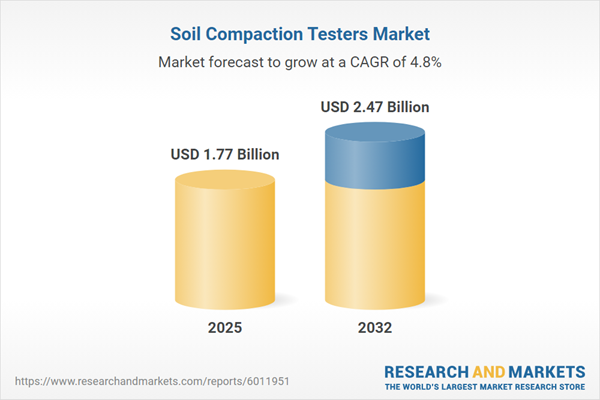Speak directly to the analyst to clarify any post sales queries you may have.
The soil compaction testers market is evolving rapidly, shaped by ongoing innovation and heightened global infrastructure activity. Senior decision-makers need to understand the forces influencing product adoption, regional demand, and site practices to align strategic investments in this dynamic landscape.
Market Snapshot: Growth Trajectory of the Soil Compaction Testers Market
The soil compaction testers market grew from USD 1.69 billion in 2024 to USD 1.77 billion in 2025 and is forecast to reach USD 2.47 billion by 2032, at a CAGR of 4.84%.
This expansion reflects critical investments in infrastructure, construction modernization, and regulatory compliance worldwide. As senior executives assess capital allocation, visibility into technology, compliance, and regional supply chain dynamics is essential for value-driven decisions in soil compaction testing.Scope & Segmentation of the Soil Compaction Testers Market
- Product Types: Jumping jack (diesel and petrol powered), plate compactors (heavy, medium, light weight), static rollers (hand operated, motorized), vibratory rollers (single drum, double drum).
- Technologies: Electromagnetic gauges (capacitive sensors, inductive sensors), GPS-based gauges, nuclear density gauges, ultrasonic gauges (contact, non-contact).
- End Uses: Agriculture, mining, construction (commercial, industrial, residential), road building (asphalt pavement, highway, railway subgrade).
- End Users: Contractors, engineering firms, government agencies, rental service providers.
- Power Sources: Battery, diesel, electric, petrol.
- Sales Channels: Direct sales, distributors, online, rental.
- Mobility Options: Handheld, portable stand, vehicle mounted.
- Regions Covered: Americas (North America – United States, Canada, Mexico; Latin America – Brazil, Argentina, Chile, Colombia, Peru), Europe, Middle East & Africa (Europe, Middle East, Africa), Asia-Pacific (China, India, Japan, Australia, South Korea, Indonesia, Thailand, Malaysia, Singapore, Taiwan).
- Company Profiles: Includes Troxler Electronic Laboratories Inc., Humboldt Mfg. Co., Proceq SA, Controls Group S.p.A., CPNuclear Limited, Hanchen Test Equipment Co. Ltd., Benetech Instruments Co. Ltd., GCTS Testing Equipment GmbH, DigiSense (P) Ventures Pvt. Ltd., Axiometrix LLC.
Key Takeaways for Senior Decision-Makers
- The primary keyword soil compaction testers market underscores a sector now seen as fundamental, driving risk mitigation in infrastructure and paving projects.
- Innovations such as GPS integration, sensor upgrades, and real-time data analytics have transformed on-site testing workflows, enabling faster compliance and actionable insights for multidisciplinary teams.
- Manufacturers are investing in energy-efficient, lightweight devices that support both operator safety and decarbonization mandates, helping clients address environmental and regulatory pressures.
- Service models are expanding to include equipment training, predictive maintenance, and data integration, ensuring comprehensive quality management for construction and infrastructure stakeholders.
- Regional variations are significant—North America prioritizes transportation and bridge renewal, EMEA focuses on quality assurance and extreme environment durability, while Asia-Pacific drives adoption through fast urbanization and strategic government incentives.
- Collaborative partnerships between hardware providers and digital platforms are enabling clients to embed compaction testing data within long-term asset management strategies, improving infrastructure lifecycle outcomes.
Tariff Impact: Adjusting to Regulatory and Trade Shifts
Recent United States tariffs on imported soil compaction testing instruments have influenced procurement decisions and production locations across North America. Some organizations have shifted to domestic alternatives or in-country assembly, while local manufacturing—supported by government incentives—is scaling to address both cost and supply chain resilience. However, smaller firms exposed to import dependencies face tighter margins, highlighting the need for adaptive sourcing and collaborative supply strategies.
Research Methodology & Data Sources
This report leverages a rigorous methodology combining primary interviews with industry stakeholders and secondary research from journals, patents, association reports, and regional development plans. Analytical techniques ensure data triangulation and accuracy. Segmentation is validated by iterative expert reviews, and methodological consistency supports reliable, actionable findings.
Why This Report Matters
- Supports evidence-based decisions on product innovation, procurement, and regional entry by clarifying emerging trends and technology adoption across target markets.
- Guides risk management and compliance strategies, especially in regions experiencing regulatory or tariff changes, enabling leaders to future-proof sourcing and investment decisions.
- Equips stakeholders with strategic insight on technology integration and service models that shape long-term infrastructure reliability and cost structures.
Conclusion
The soil compaction testers market is being reshaped by digitalization, regional policy shifts, and a commitment to sustainability. Savvy organizations that align with these trends will be well-positioned for robust project delivery and ongoing market growth.
Additional Product Information:
- Purchase of this report includes 1 year online access with quarterly updates.
- This report can be updated on request. Please contact our Customer Experience team using the Ask a Question widget on our website.
Table of Contents
3. Executive Summary
4. Market Overview
7. Cumulative Impact of Artificial Intelligence 2025
Companies Mentioned
The companies profiled in this Soil Compaction Testers market report include:- Troxler Electronic Laboratories, Inc.
- Humboldt Mfg. Co.
- Proceq SA
- Controls Group S.p.A.
- CPNuclear Limited
- Hanchen Test Equipment Co., Ltd.
- Benetech Instruments Co., Ltd.
- GCTS Testing Equipment GmbH
- DigiSense (P) Ventures Pvt. Ltd.
- Axiometrix LLC
Table Information
| Report Attribute | Details |
|---|---|
| No. of Pages | 185 |
| Published | October 2025 |
| Forecast Period | 2025 - 2032 |
| Estimated Market Value ( USD | $ 1.77 Billion |
| Forecasted Market Value ( USD | $ 2.47 Billion |
| Compound Annual Growth Rate | 4.8% |
| Regions Covered | Global |
| No. of Companies Mentioned | 11 |









